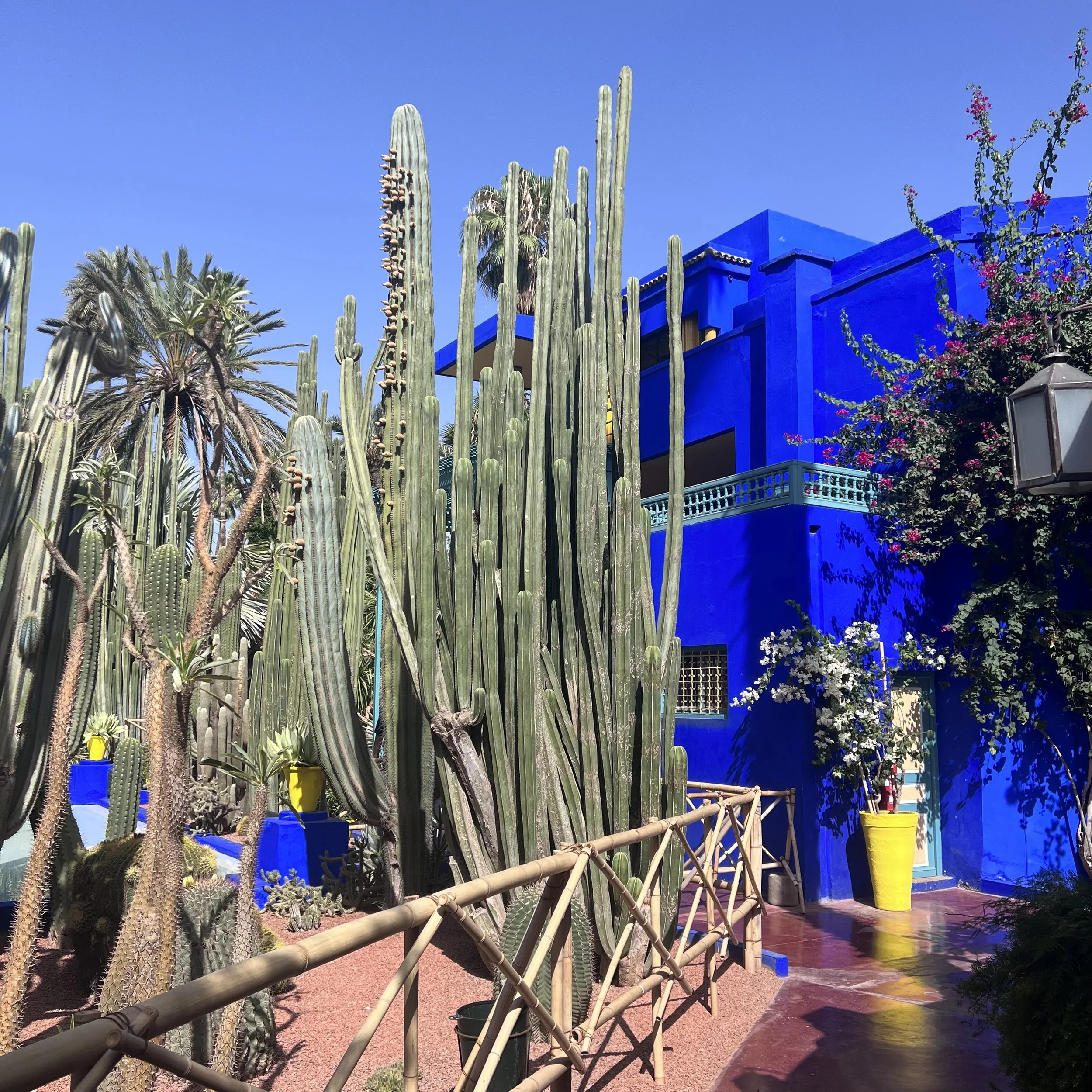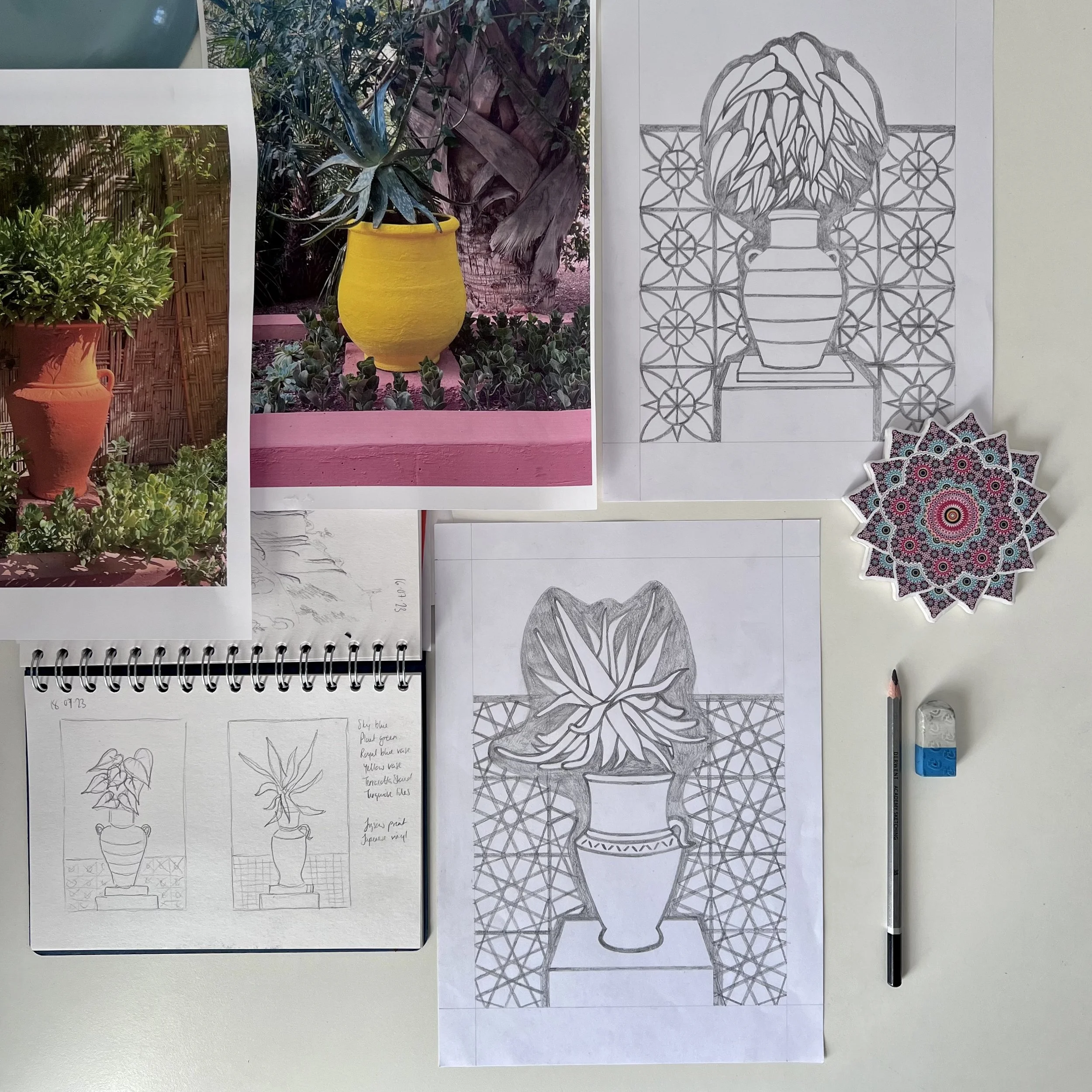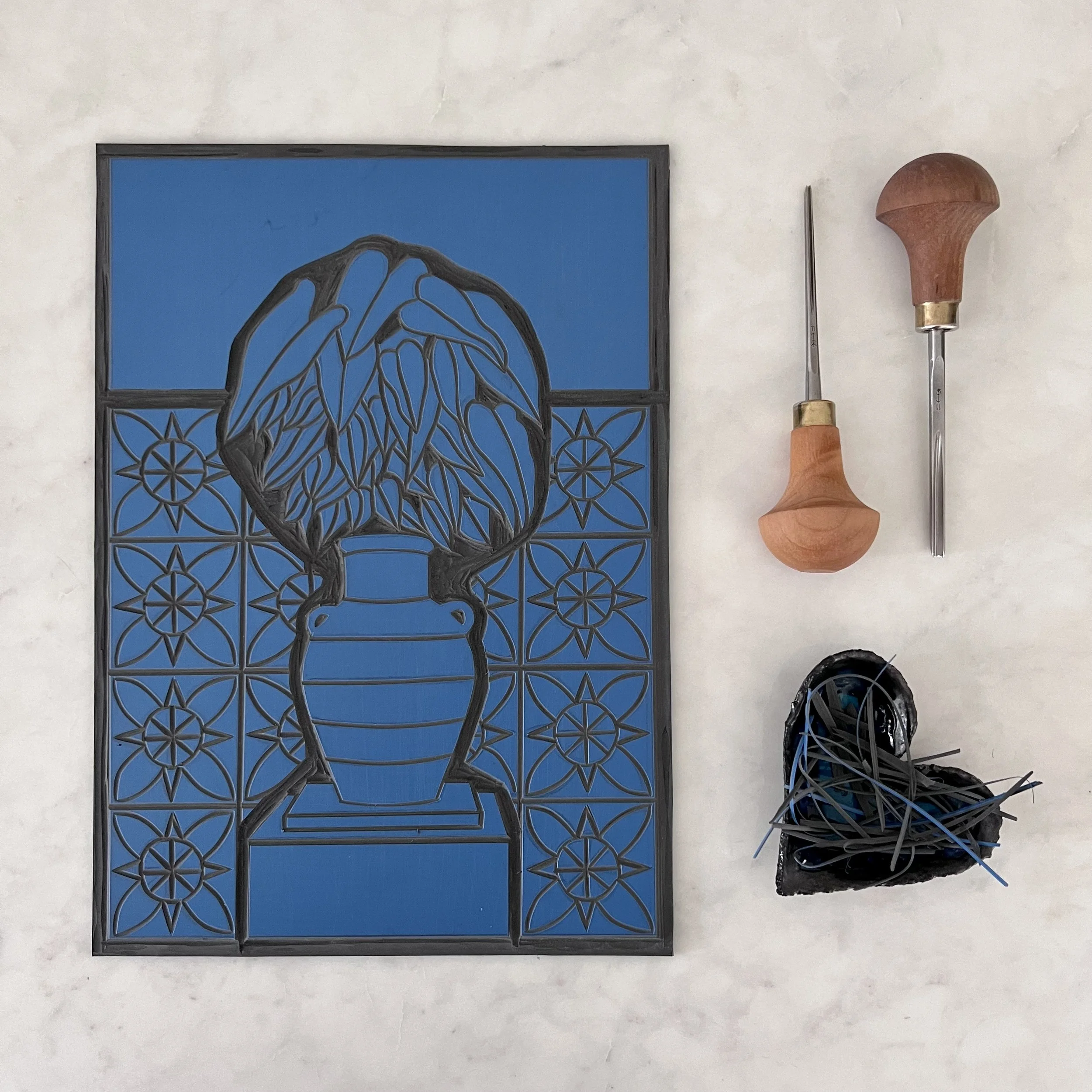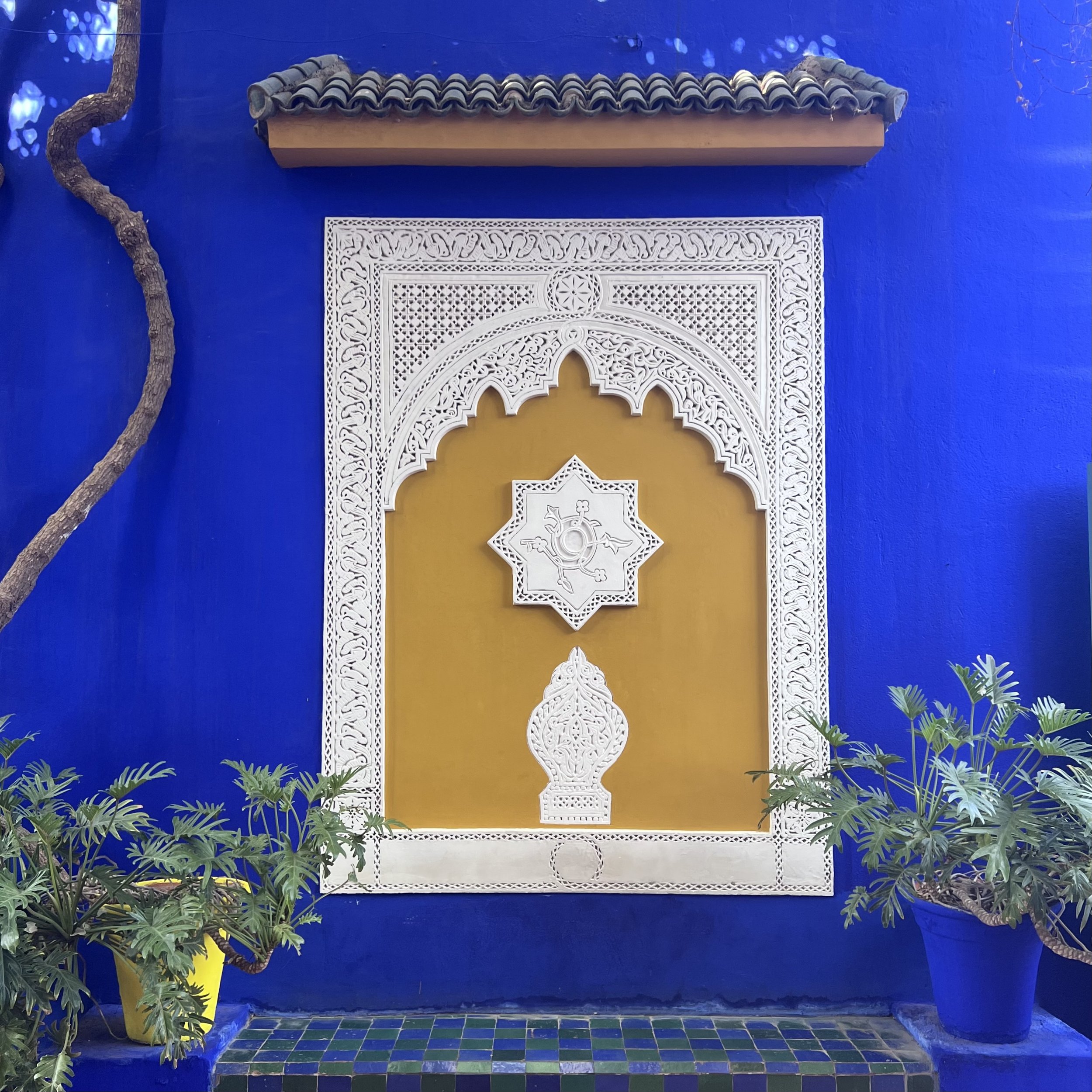Discovering Three Iconic Art Museums in Marrakesh
Jardin Majorelle in Marrakesh
In Marrakesh, where ancient traditions meet contemporary vision, three interconnected cultural spaces form an extraordinary artistic triangle.
The Yves Saint Laurent Museum, Jardin Majorelle, and the Pierre Bergé Museum of Berber Arts create a unique cultural area that goes beyond typical tourist experiences.
Located within walking distance of each other in the Gueliz district, these spaces tell the remarkable story of how a legendary French fashion designer discovered profound inspiration in Moroccan culture, restoring and reimagining a painter’s abandoned garden into one of the most iconic spaces in the city.
I visited recently and found myself especially drawn to the Jardin Majorelle. Wandering its cobalt-blue walkways beneath towering palms and bamboo groves, I found inspiration that fed into my artwork long after I had returned home.
Here, haute couture meets traditional crafts and botanical artistry intertwines with North African heritage. This cultural triangle represents a meaningful cultural exchange, offering visitors not merely beautiful objects to admire, but deep insights into how art transcends boundaries while remaining rooted in specific landscapes and traditions that give it enduring meaning and universal appeal.
Jardin Majorelle in Marrakesh
1. Yves Saint Laurent Museum Marrakesh
A must-visit for anyone interested in fashion and design, this museum celebrates the life and work of Yves Saint Laurent in a space that’s as striking as the clothes themselves. The building, designed by Studio KO, is modern and thoughtful, its textured brick facade inspired by the weave of fabric, a subtle nod to the designer’s craft.
Opening Hours: Open daily except Wednesdays, 10:00am to 6:30pm (last admission at 6:00pm)
Inside the Collection
This museum holds the most complete archive of Yves Saint Laurent’s work anywhere in the world. He was unusual in his generation for preserving his creations so carefully from the very beginning of his career. The result is a huge collection that spans over 40 years of fashion, with more than 5,000 haute couture pieces. Each one reflects not just changing styles, but shifts in society, culture, and identity.
Also included are 65 garments from his time at Dior, when he started as Christian Dior’s assistant and eventually became Creative Director. These early pieces help show how his style developed.
More Than Fashion
What makes this museum stand out is how it tells the full story of the creative process. It’s not just about finished garments; you can also see original sketches, worksheets from the atelier, and planning boards from runway shows. These give you a behind-the-scenes look at how an idea became a finished design.
I was particularly drawn to the sketches. It is inspiring to see the first rough lines that eventually became immaculate, iconic garments. It highlights how much thought, trial, and refinement go into creative work, and how essential that early spark is to the final result.
There are also costumes he created for stage and screen, including work for Catherine Deneuve in Belle de Jour and designs for the dancer Zizi Jeanmaire. It’s a reminder that his talent extended beyond fashion shows.
A Personal Connection to Marrakesh
One of the most meaningful parts of the museum is how deeply it’s rooted in its location. The permanent exhibition, Yves Saint Laurent: A Voyage to the Heart of Creation, focuses on how Marrakesh shaped his work. It features 50 pieces arranged around key themes in his design, such as Masculine/Feminine, Africa and Morocco, Gardens, Art, and Imaginary Voyages.
You can really see how the colours and atmosphere of Marrakesh influenced his designs, from the deep blues that echo the city’s skies to silhouettes inspired by traditional Moroccan clothing.
The Space and the Experience
The way the garments are displayed adds to the impact. Set against black walls with soft lighting, the clothes take centre stage . Video, music, and voice recordings add another layer, creating an immersive atmosphere that draws you into Saint Laurent’s world.
The museum also features over 1,000 vintage photographs by some of fashion’s most famous photographers, like Helmut Newton, Richard Avedon, and Irving Penn. These images helped shape how Yves Saint Laurent built the strong visual identity of his brand.
2. Jardin Majorelle
Jardin Majorelle is one of the most iconic places in Marrakesh, and for good reason. Originally designed by French painter Jacques Majorelle and later restored by Yves Saint Laurent and Pierre Bergé, the garden is a vivid, peaceful oasis in the heart of the city.
Opening Hours: Daily 8:00am to 6:30pm (last entry at 6:00pm)
A Painter’s Garden
The garden was first created in the 1920s by Jacques Majorelle, who moved to Morocco for health reasons and ended up staying for decades. He treated the garden like a canvas, combining architecture, plants, colour, and light in a way that reflected his artistic vision.
It wasn’t just a space for plants, it was a place for creativity and reflection. You can see how his love of light and shadow, bold colour, and texture shaped the space.
Majorelle Blue
The most famous feature is the electric cobalt colour now known as Majorelle Blue. It’s everywhere; in the villa, the pots, the fountains—and it absolutely pops against the surrounding greens and earthy tones. Majorelle even patented the colour. Under the bright Marrakesh sun, it somehow feels both intense and calming.
An Inspiring Place
I absolutely loved the garden. Even with plenty of visitors around, it felt tranquil; full of shade, birdsong, and quiet corners to pause. The colours are incredible in person, and they felt perfectly in tune with the Moroccan light and landscape. I found it a great place to sketch, take photos, and gather ideas for my own work. It’s easy to see why so many artists have been inspired here.
A Diverse and Thoughtful Design
The garden is home to more than 300 plant species from around the world. Towering cacti, winding paths through bamboo, flowering bougainvillea, and shady palms all coexist in carefully designed areas that shift with the light and seasons. Some spots are bright and open, while others feel cool and enclosed.
Every part of the garden feels intentional, there’s always something to look at, and the plants are arranged not just for variety, but for contrast, texture, and movement.
Yves Saint Laurent’s Legacy
When Yves Saint Laurent and Pierre Bergé bought the garden in the 1980s, it had fallen into disrepair. They restored and protected it, while keeping Majorelle’s artistic vision at the heart of the space. For Saint Laurent, it became a personal retreat and a constant source of inspiration, he often said the colours and atmosphere influenced his collections.
Today, the Fondation Jardin Majorelle looks after the garden, along with its surrounding museums and research projects. It’s not just a beautiful place to visit; it also plays an important role in preserving Moroccan heritage and supporting botanical conservation.
Jardin Majorelle in my own work
The atmosphere of the garden stayed with me after my visit. Back in my studio, I created a pair of lino prints inspired by the plant forms, colours, and sense of stillness I experienced there. Printed in Cobalt Blue, each print reflects something of that vivid, vibrant environment. You’ll find a few photos of the printmaking process below. These prints are available in my online store.
3. The Pierre Bergé Museum of Berber Arts
Tucked inside Jardin Majorelle, the Pierre Bergé Museum of Berber Arts is dedicated to showcasing the creativity and cultural heritage of the Amazigh people (commonly known as Berbers), the Indigenous population of North Africa. The museum is housed in Jacques Majorelle’s former painting studio, a symbolic setting, given Majorelle’s deep admiration for Berber culture, which he often depicted in his work.
Opening Hours: Daily, 8:30am – 6:00pm (last entry at 5:30pm)
A Rich and Diverse Collection
The museum displays more than 600 objects collected by Pierre Bergé and Yves Saint Laurent from Amazigh communities across Morocco, from the Rif Mountains to the Sahara. The collection includes jewellery, textiles, tools, pottery, musical instruments, and ceremonial items. Together, these objects reflect the depth and variety of Berber culture, which has been shaped over thousands of years.
Jewellery plays a central role in the collection, especially silver pieces worn by women that signal tribal identity, social status, or life events. Traditional garments, handwoven textiles, and decorative patterns speak to regional differences, while also showing shared cultural symbols and styles that have remained remarkably consistent over time.
Everyday Beauty and Symbolism
One of the most striking things about the museum's approach is how it highlights the beauty of everyday life. Many of the objects on display, such as storage jars, carpets, and tools, were designed for practical use, but also carefully crafted with aesthetic intention. The museum helps visitors see how function and beauty were never separate in Berber craft traditions.
The symbolic side of the culture is also explored, with explanations of how common patterns, like triangles, diamonds, or zigzags, carry meanings tied to protection, femininity, fertility, or nature. These symbols appear across many different mediums, creating a kind of visual language that runs through Berber art and design.
A Living Culture
The museum presents Amazigh culture not as a thing of the past, but as a living tradition. It includes videos, music, and maps to give context and show how many of these customs continue today, especially in rural parts of Morocco. It also draws attention to how Amazigh influences can still be seen in modern Moroccan art, fashion, and architecture.
With a focus on both preservation and education, the museum helps visitors understand how deeply rooted this culture is in Moroccan identity, and how its traditions continue to evolve.
The Cultural Triangle: A Unified Experience
Together, the Yves Saint Laurent Museum, Jardin Majorelle, and the Pierre Bergé Museum of Berber Arts offer a rich and rewarding way to experience Marrakesh. Each space tells its own story, of fashion inspired by local culture, of a garden shaped by artistic vision, and of an Indigenous heritage that continues to influence Moroccan life today. Seen together, they can give a fuller picture of how creativity and culture are deeply connected.
If you're planning a visit, you can book tickets to each site individually through their official websites. Alternatively, it may be easier to book a combined visit or guided experience through platforms like Get Your Guide, especially if you're short on time or want to learn more along the way. Either way, it’s worth setting aside half a day to explore the three locations at your own pace.
Other Cultural Things to Do In and Around Marrakesh
Explore the Souks
No trip to Marrakesh is complete without exploring the souks. These busy market streets in the old medina are full of colour, noise, and life. You’ll find handmade metalwork, textiles, carpets, spices, leather goods, ceramics, and souvenirs of every kind. Each area of the souk has its own speciality, like the dyers’ souk with rows of brightly coloured fabrics or the spice souk with its heady scents and natural remedies.
I really enjoyed wandering through the souks, chatting with stallholders, and picking up a few souvenirs to bring home. It’s a fun and sometimes chaotic experience, but a great way to connect with the city's creative energy.
Djemaa el-Fna Square
The main square in Marrakesh is a hub of activity, especially at sunset. During the day, you’ll see performers, henna artists, and food vendors. In the evening, it turns into an open-air dining and entertainment space with street food, music, and live shows. It can get crowded, but it’s worth visiting to soak up the atmosphere and see this long-standing cultural tradition in action.
Medersa Ben Youssef
This former Islamic college is a quiet, striking example of Moroccan architecture. The intricate carvings, patterned tiles, and peaceful courtyard give a sense of what student life might have been like centuries ago. It’s a good stop for anyone interested in history or design.
Saadian Tombs
These royal tombs were hidden for centuries and rediscovered in the early 20th century. They hold members of the Saadian dynasty and are decorated with fine tilework, marble, and plaster carving. The site is compact, so it's a quick visit, but the craftsmanship is worth seeing.
Bahia Palace
This 19th-century palace is full of tiled courtyards, painted ceilings, and carved wooden details. Walking through its rooms and gardens gives a glimpse into the lives of Moroccan nobles and the country’s architectural traditions. It’s a calm spot that contrasts nicely with the busy streets outside.
Atlas Mountains Day Trip
One of the highlights of my trip was a day trip to the Atlas Mountains. We visited several small Berber villages, walked through green valleys, and enjoyed a traditional Moroccan lunch with incredible views. The scenery was breathtaking, especially the waterfalls, where locals were swimming and diving from the rocks. We also spotted monkeys along the route, which added a bit of unexpected excitement to the day. It was a brilliant way to experience Morocco beyond the city and get a sense of rural life and natural beauty.
Traditional Hammam
If you're curious about Moroccan wellness rituals, try a traditional hammam. These public bathhouses offer steam rooms, scrubs with black soap, and massages with argan oil. Some are simple and traditional; others more modern and spa-like. It’s a great way to relax and experience an important part of local life.
Have a Question or Want to Share Your Experience?
If you have any questions about the places mentioned in this post, or if you’ve been to Marrakesh and want to share your favourite spots, I’d love to hear from you. Send me an email at sarahransomeart@gmail.com, I'm always happy to chat about travel, art, and inspiration.
Some of the links you’ll find in this blog post may earn me a small commission. This doesn’t cost you anything extra and helps support the work I do in creating valuable content.


























